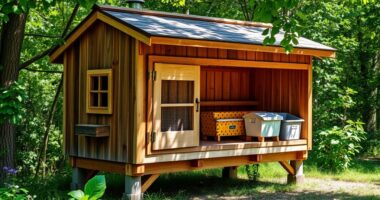Wooden sandpits offer great benefits for your child’s development and outdoor fun. They support sensory growth by providing textured sand to explore while encouraging fine and gross motor skills through digging, pouring, and climbing. Plus, they inspire creativity and imaginative play, helping children build and tell stories. These natural, sturdy structures promote social skills through sharing and teamwork, all while creating a safe, eco-friendly space to learn and relax. Keep exploring to discover more about how they can benefit your family.
Key Takeaways
- Promote sensory development, emotional regulation, and mindfulness through tactile sand play and natural materials.
- Enhance fine and gross motor skills, balance, and strength with active sandpit play and climbing.
- Foster creativity, imagination, and storytelling with open-ended building and construction opportunities.
- Support social skills, cooperation, and inclusive play in a shared, open environment.
- Provide a safe, eco-friendly play space with durable, natural wood that encourages exploration and learning.
Promoting Sensory Development and Regulation
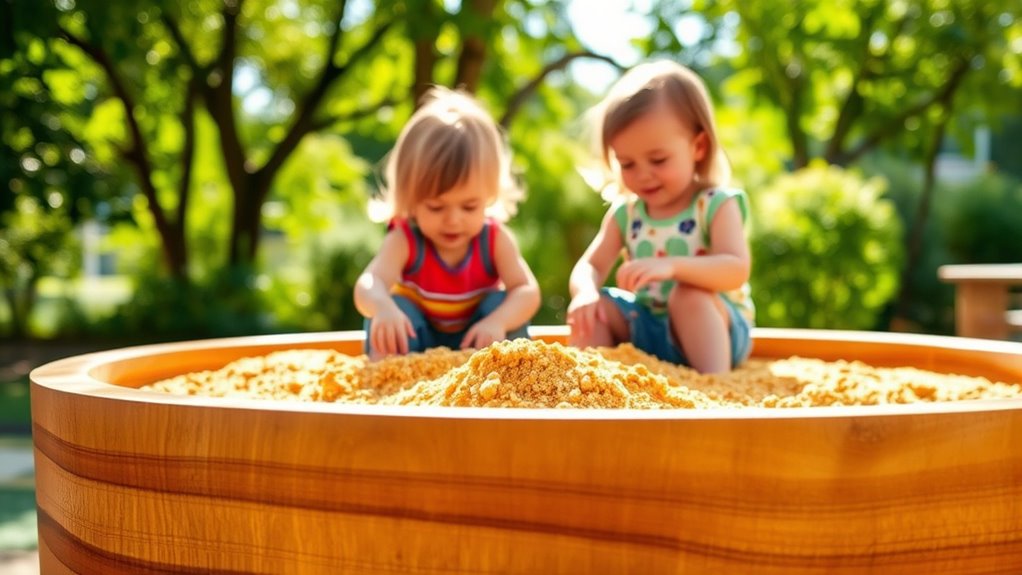
Wooden sandpits naturally support sensory development by providing children with a rich tactile environment. As you encourage tactile exploration, kids engage with the grainy texture of the sand, helping improve their sensory integration. The stable, smooth surface of wooden sandpits offers a calming sensory experience, vital for sensory regulation, especially for children with sensory processing differences. Playing in a wooden sandpit helps develop tactile discrimination skills by encountering varied textures, temperatures, and moisture levels. The natural material creates a warm, inviting setting that encourages sustained engagement. Regular use promotes sensory calming, aiding children in self-regulation and reducing sensory overload. Additionally, the durability of wooden sandpits ensures long-lasting use, providing a reliable environment for ongoing sensory play. The use of natural materials like wood aligns with sensory-friendly design principles that prioritize tactile comfort and safety. Incorporating virtual or digital elements into sensory play can further enhance development, especially in a structured way. Understanding the importance of material properties can help caregivers select the best outdoor play equipment for sensory needs. Recognizing the environmental benefits of wooden play equipment can also support eco-friendly choices in outdoor play areas. Overall, wooden sandpits serve as an effective tool for nurturing sensory development and supporting children’s sensory regulation through engaging, calming play environments.
Supporting Fine and Gross Motor Skills
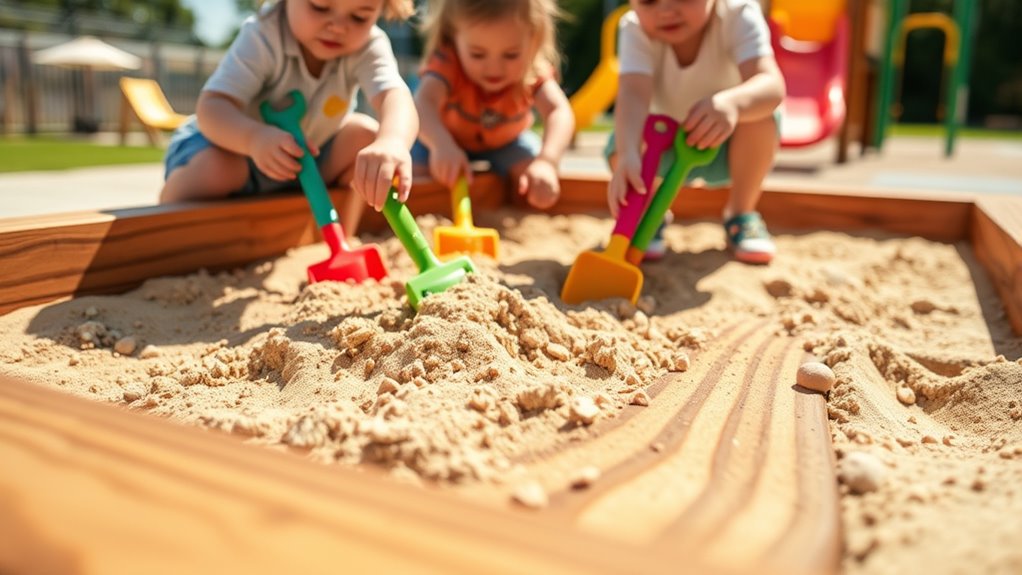
Wooden sandpits are excellent for boosting your child’s motor skills through active play. As they scoop, dig, and manipulate sand, they improve hand-eye coordination and develop strength and dexterity. Climbing in and out also helps build balance, stability, and overall muscle control. Incorporating sensory play activities like sand manipulation can further enhance tactile development and cognitive skills. Engaging in outdoor activities within a sandpit encourages physical exercise and social interaction, supporting overall development. Additionally, integrating machine learning insights can help tailor play experiences to optimize developmental benefits.
Enhances Hand-Eye Coordination
Playing in a sandpit naturally boosts hand-eye coordination as children scoop, pour, and dig with purpose. Wooden sandpits encourage children to manipulate tools like shovels, buckets, and molds, which sharpens their hand-eye coordination through precise aiming and placement. As kids build sandcastles and fill containers, they refine their fine motor skills and dexterity. Developing these skills early can also support emotional bonds as children share and collaborate during play. This play equipment promotes active engagement, helping children develop essential manipulation skills.
Promotes Balance and Stability
As children manipulate tools and build structures in a sandpit, developing their balance and stability becomes a natural part of play. A sturdy wooden sandpit provides a stable platform, reducing wobbling and tipping on outdoor surfaces. Its solid construction supports safe climbing and stepping, enhancing gross motor skills. The weight and durability of wood contribute to overall stability, minimizing the risk of collapse. Additionally, a well-designed wooden sandpit maintains balance on uneven ground, ensuring safety during active play. The textured surface of wood aids tactile awareness, supporting fine motor control. Incorporating a well-designed structure can further improve stability and safety for young users, especially when considering home safety standards that benefit from stable setups in outdoor play areas.
Develops Strength and Dexterity
Engaging children in activities like digging, scooping, and pouring in a sandpit actively builds their strength and dexterity. As they manipulate sand and tools, their fine motor skills improve, giving them better control over finger movements. Climbing in and out enhances gross motor skills, balance, and coordination. Here are three key benefits:
- Strengthening muscles through digging and lifting sand helps with daily tasks and play.
- Developing finger dexterity by shaping molds and using shovels boosts fine motor control.
- Improving overall coordination as children reach across and move around the sandpit supports spatial awareness.
- Using diverse toys and tools in the sandpit can further enhance their motor skill development and keep play engaging. Incorporating natural materials like sticks and stones can also stimulate creativity and sensory development. Additionally, engaging with outdoor environments promotes healthy physical activity and sensory exploration. Playing in a wooden sandpit isn’t just fun—it’s a powerful way to foster physical development, muscle control, and motor skills that last a lifetime. Including varied play surfaces can also support different types of movement and challenge their developing skills even further.
Encouraging Creativity and Imaginative Play
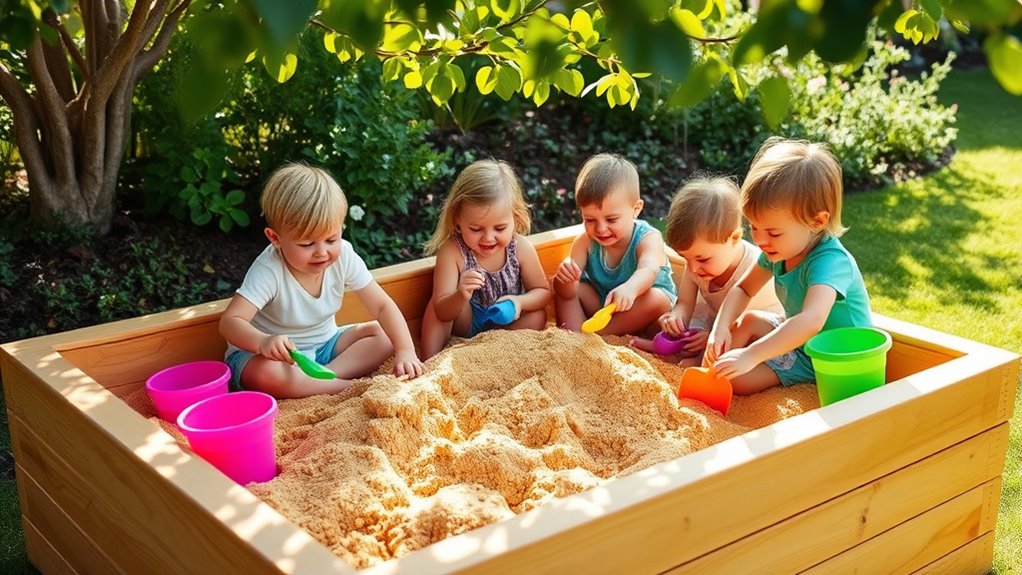
A wooden sandpit offers a perfect space for your child to create stories and build unique structures. With its open design, they can imagine castles, forts, or pirate ships, turning the sandbox into a world of adventure. This encourages endless possibilities for creative expression and imaginative play. Additionally, a well-constructed wooden sandpit can provide a durable and safe environment for kids to explore their creativity over time child safety. Using materials and construction best practices ensures the longevity and safety of the sandbox. Incorporating sensory toys can further enhance the tactile experience and stimulate your child’s senses during play.
Fostering Creative Storytelling
Wooden sandpits act as a blank canvas that sparks children’s imagination, encouraging them to invent stories and craft their own worlds through building and shaping sand. This open-ended play nurtures creative storytelling, where kids can envision adventures, castles, or explorers discovering new lands. The natural texture and aesthetic appeal of wood stimulate sensory exploration, inspiring children to experiment with different tools and toys. As they build and shape, their imagination flourishes, turning simple sand into a setting for vivid narratives. Plus, engaging in shared sand play promotes social collaboration, allowing kids to co-create stories and exchange ideas. These moments not only boost creativity but also help children develop communication skills and a love for storytelling that lasts.
Building Unique Sand Constructions
Building on the creative storytelling fostered by sand play, wooden sandpits serve as a sturdy foundation for kids to design and construct unique structures. With their durable, natural surfaces, you can encourage children to experiment with building castles, tunnels, and sculptures, fueling their creativity. The open-ended space promotes imagination, allowing kids to invent new games and scenarios using sand and accessories like molds. The sturdy construction supports diverse building techniques, inspiring innovative design and artistic expression. Playing in a wooden sandpit also offers sensory benefits, as children explore different textures while shaping their ideas. This versatile environment helps kids develop their skills in building and design, making each imaginative construction a meaningful step in their creative growth.
Facilitating Social Interaction and Cooperation
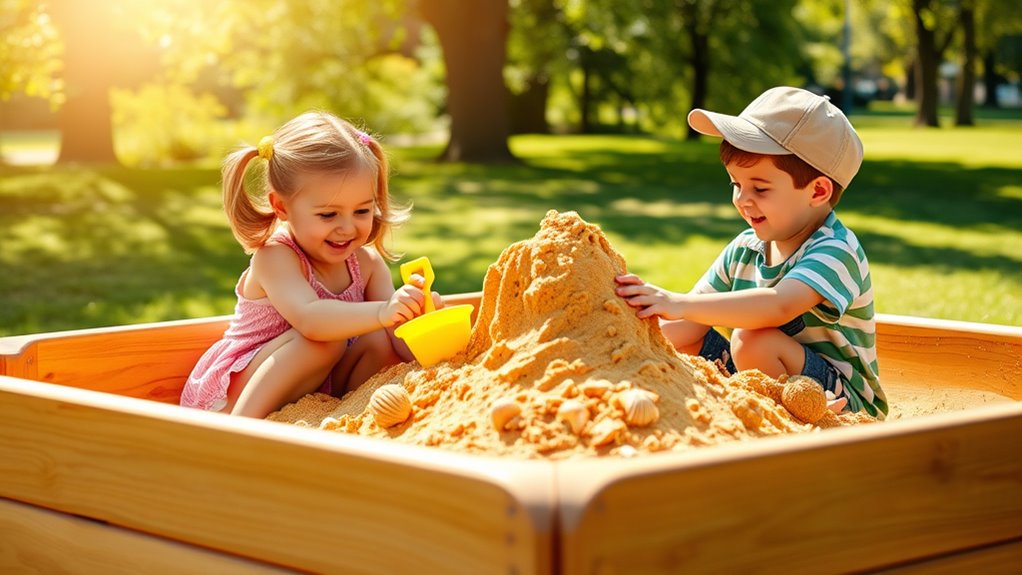
Because of their sturdy and open design, wooden sandpits naturally encourage children to interact and cooperate. This shared space promotes social interaction by inviting kids to play side-by-side and collaborate on projects. As they engage in group play, they develop essential teamwork skills, like sharing tools and building together. The open layout also makes communication easier, fostering conversations and negotiations that improve their social skills.
Here are three ways a wooden sandpit supports social development:
- It inspires inclusive play, welcoming children from diverse backgrounds.
- It strengthens bonds through cooperative behaviors like taking turns and helping peers.
- It creates a safe environment where children feel comfortable expressing themselves and working as a team.
Enhancing Early Mathematical and Scientific Understanding
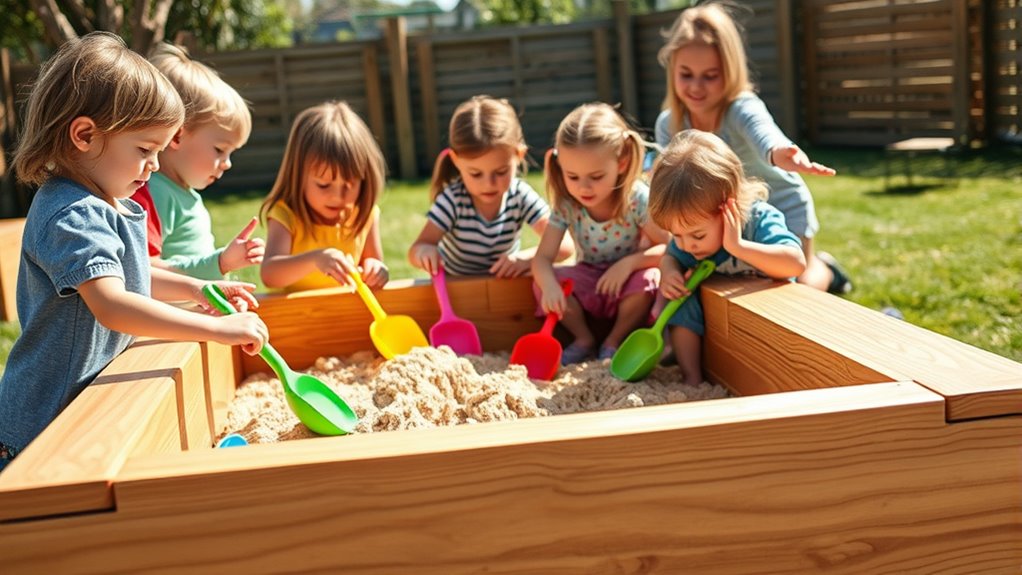
Playing in a wooden sandpit naturally enhances early mathematical and scientific understanding by encouraging you to explore concepts like volume, measurement, and physical properties through hands-on activities. As you pour sand into containers, you learn about capacity and how different shapes hold varying amounts of sand. Manipulating sand with tools like shovels, buckets, and molds fosters exploration of geometric shapes, spatial relationships, and scientific principles such as erosion and flow. The tactile experience helps you grasp measurement, weight, and the properties of natural materials. Playing with sand also promotes inquiry into natural phenomena like gravity, displacement, and absorption. The open-ended nature of sand play invites experimentation and discovery, laying a strong foundation for developing your mathematical and scientific thinking skills.
Providing a Safe and Natural Play Environment
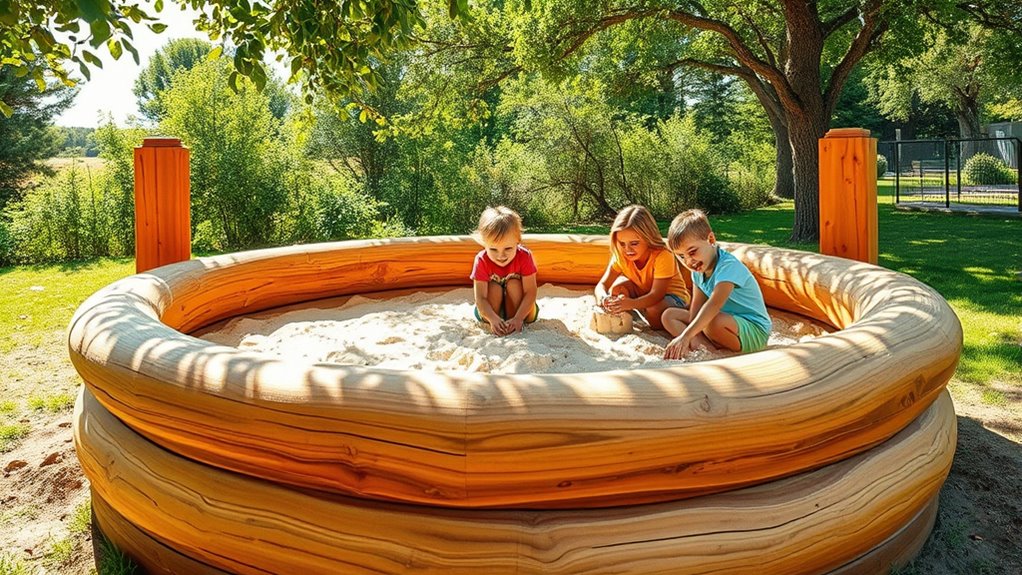
A wooden sandpit offers a natural and safe environment for children to enjoy outdoor play. Made from natural, untreated wood, it’s eco-friendly and free from harmful chemicals, supporting healthier play. Its sturdy construction ensures durability, reducing the risk of breakage or splinters, so you can trust it to stay safe over time. The natural materials blend seamlessly into outdoor settings, creating a calming space where kids can explore freely. To keep your child safe and engaged, look for features like:
- Smooth edges and raised sides to prevent sand spillage and injuries
- Solid, eco-friendly wood that withstands outdoor elements
- A design that encourages safe, imaginative play in a natural environment
This setup promotes safety while nurturing a connection with nature.
Boosting Emotional Well-being and Focus
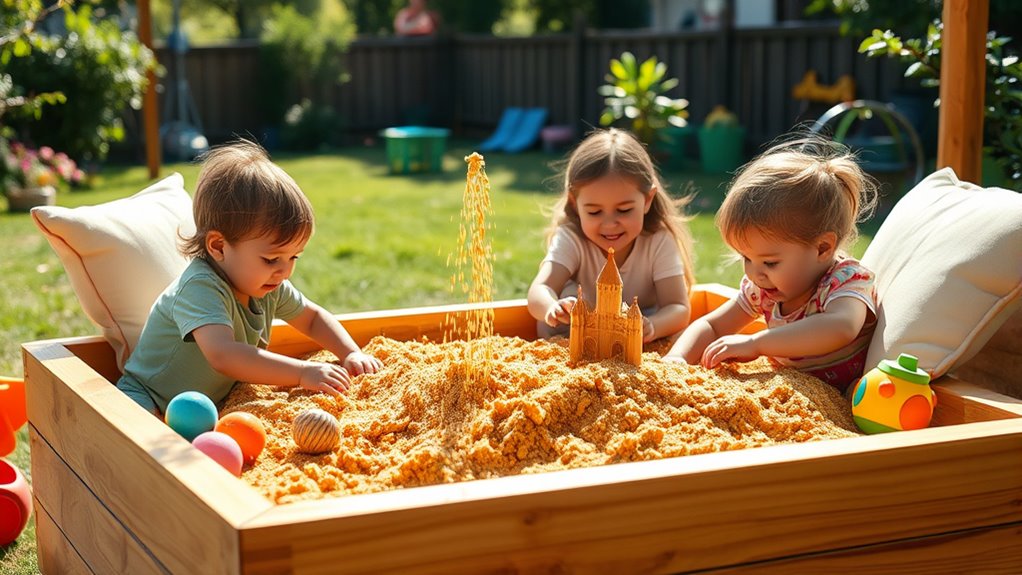
Using a wooden sandpit can considerably boost your child’s emotional well-being and focus, as the calming outdoor environment helps reduce stress and promotes relaxation. Playing with natural materials like wood and sand offers a sensory activity that enhances emotional regulation, allowing children to process feelings more effectively. The tactile experience of building and shaping sand structures encourages concentration and attention span during outdoor play. Engaging with these natural elements fosters mindfulness and a connection to nature, which supports overall emotional health. As children manipulate sand and create, they develop confidence and a sense of achievement, further strengthening their emotional well-being. A wooden sandpit provides a peaceful setting that nurtures focus, emotional regulation, and a positive outlook, making outdoor play truly beneficial.
Frequently Asked Questions
How Does a Sand Pit Help a Child’s Development?
A sandpit helps your child’s development by encouraging sensory exploration and fine motor skills through tactile play. It boosts their cognitive growth as they measure, build, and experiment with sand. Playing together in a sandpit fosters social skills like sharing and collaboration. It also promotes emotional regulation and sensory processing, especially for children with autism or sensitivities, making it a valuable outdoor activity that supports overall growth and development.
What Are the Benefits of Wooden Playgrounds?
Did you know that wooden playgrounds often last 20-25 years with proper maintenance? You’ll appreciate that they’re made from sustainable materials, blending beautifully into outdoor spaces. Wooden structures are sturdy, weather-resistant, and customizable with slides, swings, or climbing frames. They encourage kids to stay active, explore, and use their imagination. Plus, their timeless look adds charm to any yard, making outdoor play safe, durable, and visually appealing.
What Are the Learning Outcomes of Sandpit?
When you consider the learning outcomes of a sandpit, you see how it helps children develop essential skills. You’ll notice them improving their sensory awareness as they explore textures and colors. They’ll also strengthen fine motor skills through digging and pouring. Plus, they learn about measurements and volume, boost their creativity, and build social skills by sharing and collaborating. A sandpit truly fosters well-rounded development in a fun, natural setting.
What Are the Benefits of Sandbox for Kids?
A sandbox is like a treasure chest waiting to be explored. It offers your kids a safe space to develop motor skills through digging and pouring, stimulating their senses with varied textures. Plus, it sparks imagination, turning ordinary outdoor areas into magical worlds. With its natural look and durability, a sandbox becomes a essential part of outdoor fun, encouraging physical activity and creative play that benefits their growth.
Conclusion
A wooden sandpit isn’t just a play area; it’s a gateway to growth, creativity, and connection. Imagine watching your child’s senses flourish, their imagination soar, and friendships blossom—all within a natural, safe space. Just as a garden nurtures blooms, a sandpit nurtures development and joy. By choosing a wooden sandpit, you’re planting the seeds for a lifetime of learning and happiness—because the best adventures begin in the simplest of places.



